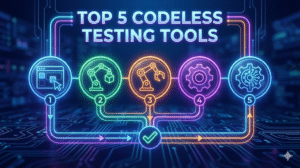CloudQA's Self-Healing Test Execution: The Future of Quality Assurance with ML
Introduction:
What Is Self/Auto-Healing Test Execution, and Why Does It Matter?
Examples of Test Execution Woes
CloudQA's Self-Healing Test Execution Solution
Q1: What types of issues can self-healing test execution address?
A1: Self-healing test execution can resolve issues such as broken locators, altered UI elements, intermittent test failures, and changes in the application’s workflow.
Q2: Is self/auto-healing suitable for all types of automated tests?
A2: Yes, self/auto-healing is beneficial for various automated tests, including UI tests, regression tests, and end-to-end tests. Its applicability depends on your testing framework and specific test requirements.
Q3: What challenges come with implementing self/auto-healing in test execution?
A3: Implementing self/auto-healing can be challenging. You may need to configure self-healing algorithms, prevent false positives, and fine-tune the system for specific application changes.
Why CloudQA's ML-Powered Approach Matters
Benefits of CloudQA's ML-Powered Approach
- Enhanced Stability: CloudQA employs ML algorithms to replace broken locator values instantly, ensuring tests not only adapt but anticipate changes, future-proofing your testing efforts.
- Real-Time Adaptation: CloudQA dynamically adjusts tests during runtime, allowing them to remain effective as your web application evolves.
- Minimized Maintenance Efforts: Self-healing test execution significantly reduces non-product-related test failures, freeing up resources for more critical tasks.
- Actionable Insights: CloudQA’s reports provide actionable insights, making test maintenance a breeze with new values accessible through a simple click.
How Does Machine Learning (ML) Contribute to Self/Auto-Healing in Test Execution?
Best Practices for Effective Implementation
Features of CloudQA's ML-Infused Solution
CloudQA empowers your automation testing efforts with a wealth of ML-infused features:
- Adaptability: Stay ahead of UI changes with CloudQA’s ML-driven approach.
- Proactive Self-Healing: ML algorithms replace “broken” locators during runtime without manual intervention.
- Robust E2E Test Stability: UI changes no longer disrupt end-to-end tests, thanks to CloudQA’s adaptability.
- Seamless Handling of NoSuchElement Failures: CloudQA ensures smooth, error-free test execution by replacing failed controls with new values.
- Effortless Test Maintenance: Control updates in automated tests become streamlined, courtesy of ML-driven insights.
- Advanced Features Support: CloudQA offers support for parallel test runs, remote test runs, IFrames, Shadow DOMs, Actions, and integration with ALM tools.
- Visualized Controls State: Detailed reporting, enriched with insights, provides a comprehensive view of fixed control values and includes screenshots for better analysis.
- Mobile Testing: CloudQA’s ML capabilities extend seamlessly to mobile web testing, making it a versatile and future-ready solution.
Assessing ROI for Self/Auto-Healing in Test Execution
Conclusion
CloudQA, with its ML-infused self-healing approach, has elevated the standard for test automation stability. It not only corrects failures but also anticipates and adapts to changes proactively. While CloudQA has been a trusted solution for stable UIs with its codeless testing, it’s a game-changer for applications undergoing frequent changes, delivering substantial ROI. This AI-driven automation represents a significant leap toward building and maintaining resilient automation suites.
This article has offered a glimpse into CloudQA’s ML-driven capabilities. Stay tuned for our upcoming blog, which will provide detailed, step-by-step tutorials on leveraging CloudQA’s ML for enhanced test automation stability.
RECENT POSTS
Guides

How To Select a Regression Testing Automation Tool For Web Applications
Regression testing is an essential component in a web application development cycle. However, it’s often a time-consuming and tedious task in the QA process.

Switching from Manual to Automated QA Testing
Do you or your team currently test manually and trying to break into test automation? In this article, we outline how can small QA teams make transition from manual to codeless testing to full fledged automated testing.

Why you can’t ignore test planning in agile?
An agile development process seems too dynamic to have a test plan. Most organisations with agile, specially startups, don’t take the documented approach for testing. So, are they losing on something?

Challenges of testing Single Page Applications with Selenium
Single-page web applications are popular for their ability to improve the user experience. Except, test automation for Single-page apps can be difficult and time-consuming. We’ll discuss how you can have a steady quality control without burning time and effort.

Why is Codeless Test Automation better than Conventional Test Automation?
Testing is important for quality user experience. Being an integral part of Software Development Life Cycle (SDLC), it is necessary that testing has speed, efficiency and flexibility. But in agile development methodology, testing could be mechanical, routine and time-consuming.






